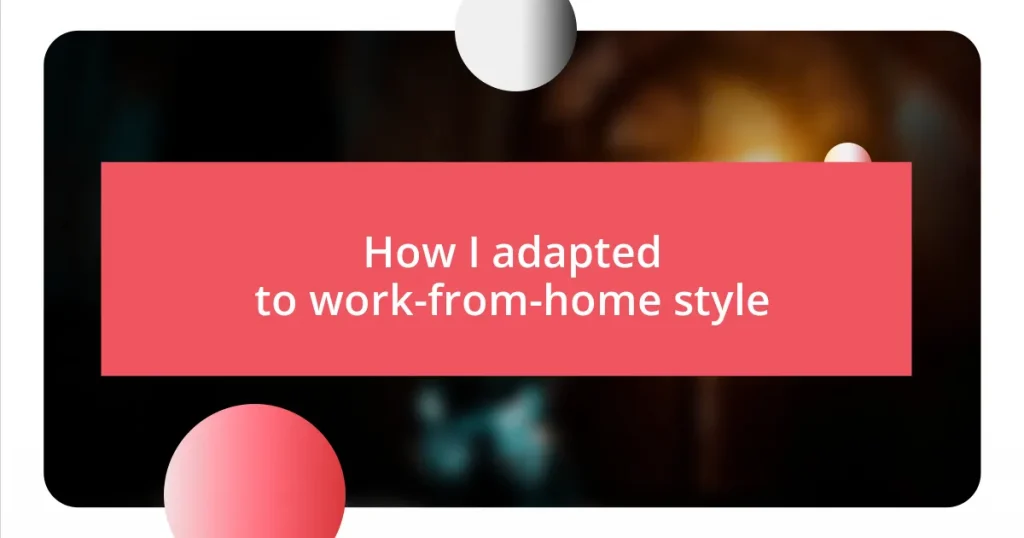Key takeaways:
- Isolation and loss of spontaneous interactions can hinder remote work; prioritizing connection with colleagues is essential.
- Establishing a dedicated workspace helps improve focus and sets clear boundaries between work and personal life.
- Creating a structured daily routine enhances productivity and provides a sense of control while working from home.
- Utilizing productivity tools effectively fosters collaboration and helps manage tasks, leading to a more integrated work experience.
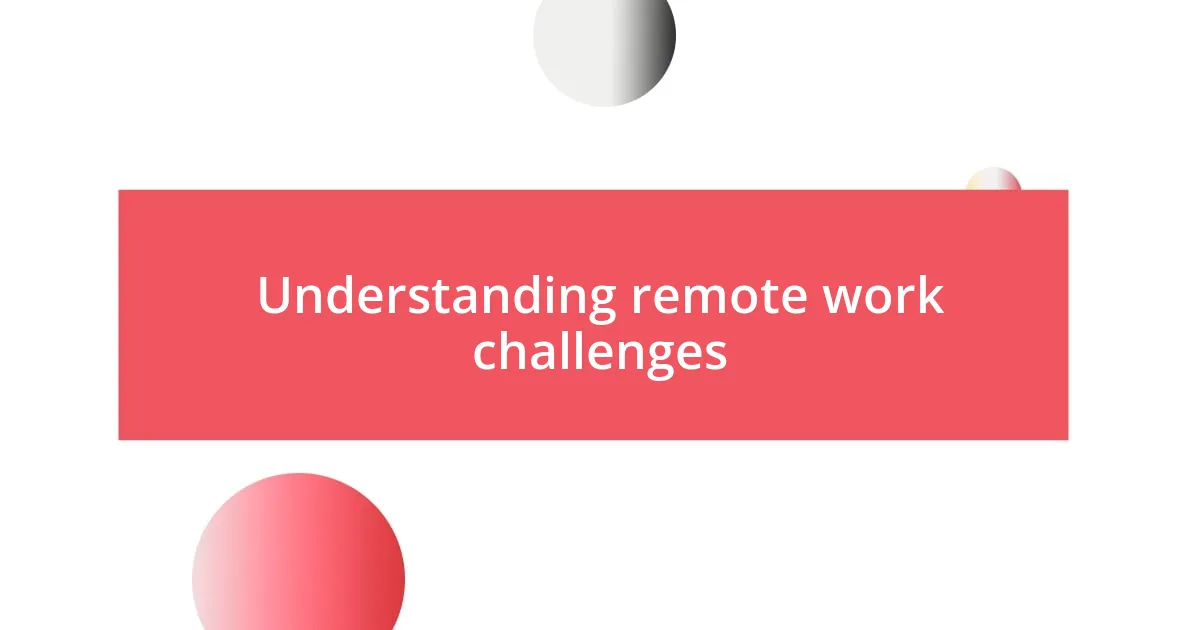
Understanding remote work challenges
One of the biggest challenges I faced when transitioning to remote work was the isolation that can easily creep in. In the early days, I remember sitting in my home office, surrounded by silence, and reflecting on just how much I missed the spontaneous conversations with coworkers. Don’t you sometimes crave that human connection? It’s a reminder that while working from home offers flexibility, it can also make us feel disconnected from our teams.
I often found it hard to draw boundaries between work and personal life. On weekends, I’d catch myself opening my laptop to check emails, thinking, “Just a quick look won’t hurt.” The irony hit me hard when I realized that my relaxation time was slipping away. Have you experienced that tug-of-war between being productive and trying to unwind? Recognizing the need for a clear separation helped me create a more balanced routine.
Technology is both a lifeline and a source of frustration. I’ve had my fair share of video call mishaps—including the dreaded moments when my internet suddenly drops during crucial meetings. It can be incredibly frustrating and sometimes embarrassing. But how often do we consider how these hiccups can build resilience and foster patience in our online interactions? It’s all part of this remote work journey—a series of challenges that teach us to adapt and grow.
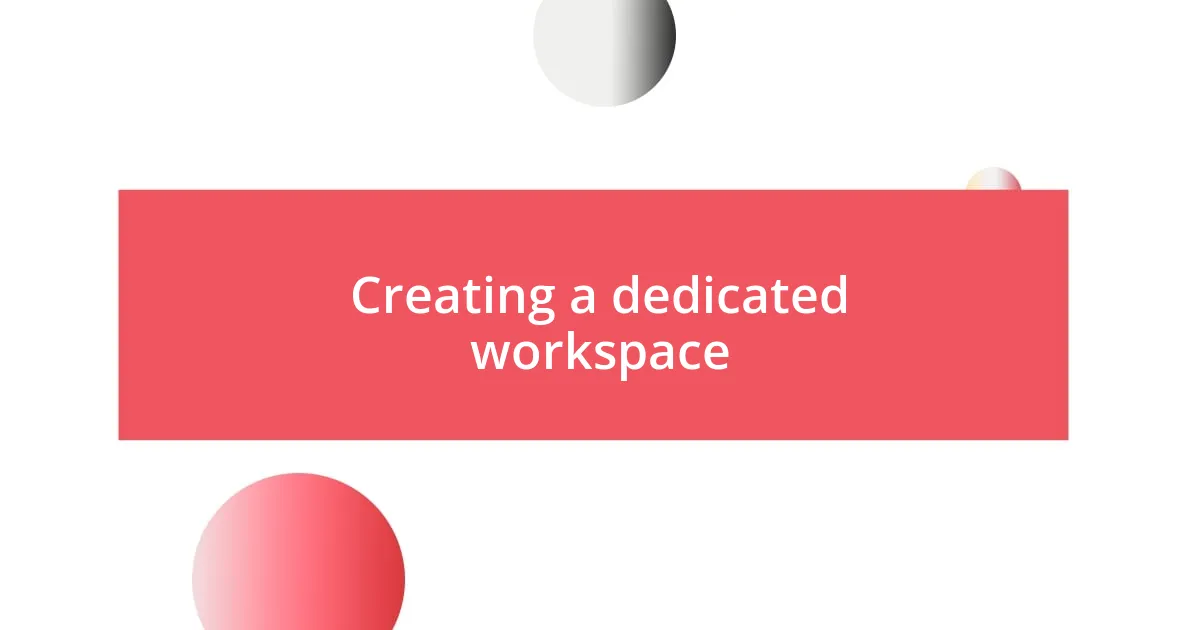
Creating a dedicated workspace
Creating a dedicated workspace has been pivotal in my journey to thriving in a work-from-home environment. At first, I sprawled across the couch, laptop perched awkwardly on my lap, thinking comfort would fuel my productivity. In reality, it just led to distractions and discomfort. Once I carved out a specific area in my home for work, focusing became so much easier. It was almost like my brain flipped a switch. Have you ever noticed how your surroundings can impact your mood?
Setting up my workspace involved more than just a desk and chair; I infused it with personal touches that inspire me. I hung framed pictures, added plants, and even placed my favorite coffee mug on the table. This little ritual brightens my day, adding a spark of joy every time I settle in to work. I realized that every element in my space could either enhance or detract from my focus.
Creating boundaries was another essential step. I made a rule to only use my workspace for work-related tasks, which helped signal to my family that I was in ‘work mode’. It was a learning curve; I communicated with my family about respecting my workspace, and eventually, they adapted. Do you have a dedicated spot for work? This simple decision could transform how you approach your daily grind.
| Before Dedicated Workspace | After Dedicated Workspace |
|---|---|
| Distractions everywhere | Focused environment |
| Lack of routine | Cleansed work-life boundaries |
| Physical discomfort | A comfortable setup |
| Low productivity | Enhanced creativity |
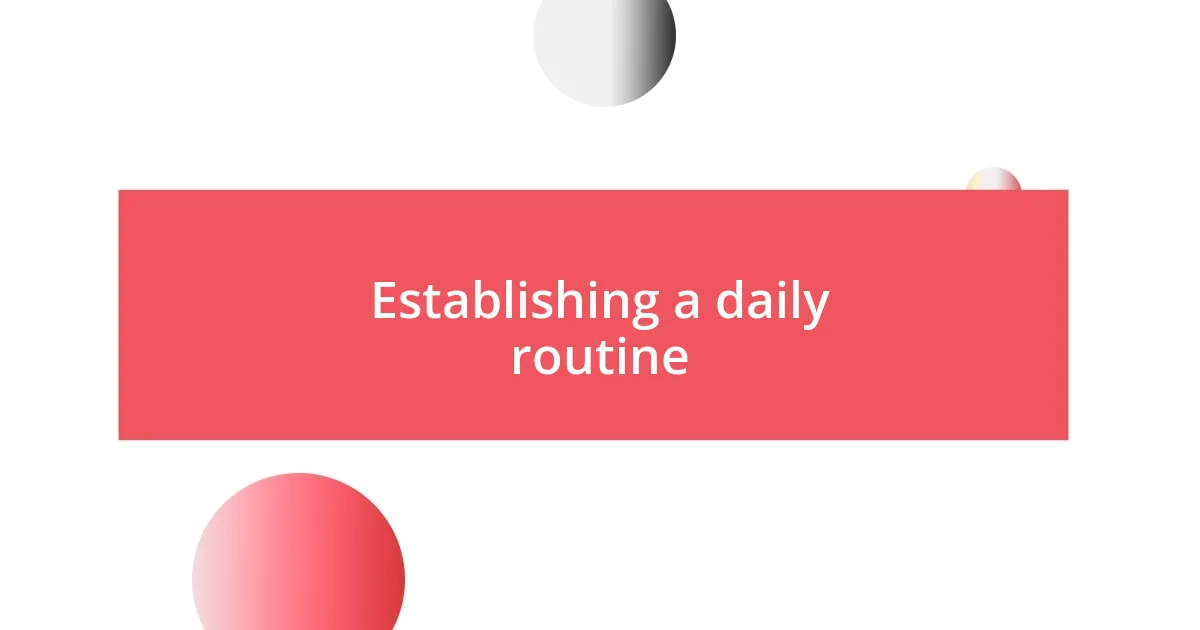
Establishing a daily routine
Establishing a daily routine has been a game-changer for me. In the beginning, I struggled to find a rhythm, often wandering aimlessly between tasks and losing precious time. It was like being in a fog; I knew I had work to do, but without direction, I found myself distracted. Once I committed to a structured schedule, everything changed. I felt more in control, which ultimately boosted my motivation and productivity.
Here are some key tips that helped me solidify my routine:
- Set consistent wake-up and start times: This conditions your mind to be ready for work.
- Allocate specific blocks for tasks: Break down your workload into manageable chunks.
- Incorporate breaks: Short, occasional breaks can recharge your energy and maintain focus.
- Schedule meals just like work meetings: Keeping mealtimes consistent prevents mindless snacking and helps maintain energy levels.
- End your workday at the same time: This helps create a clear boundary between work and personal time.
Creating this daily structure became not just a habit, but a comforting framework that I could rely on, much like clockwork. It allowed me to embrace my remote lifestyle more fully, knowing that I had guidelines to follow within the freedom of working from home.
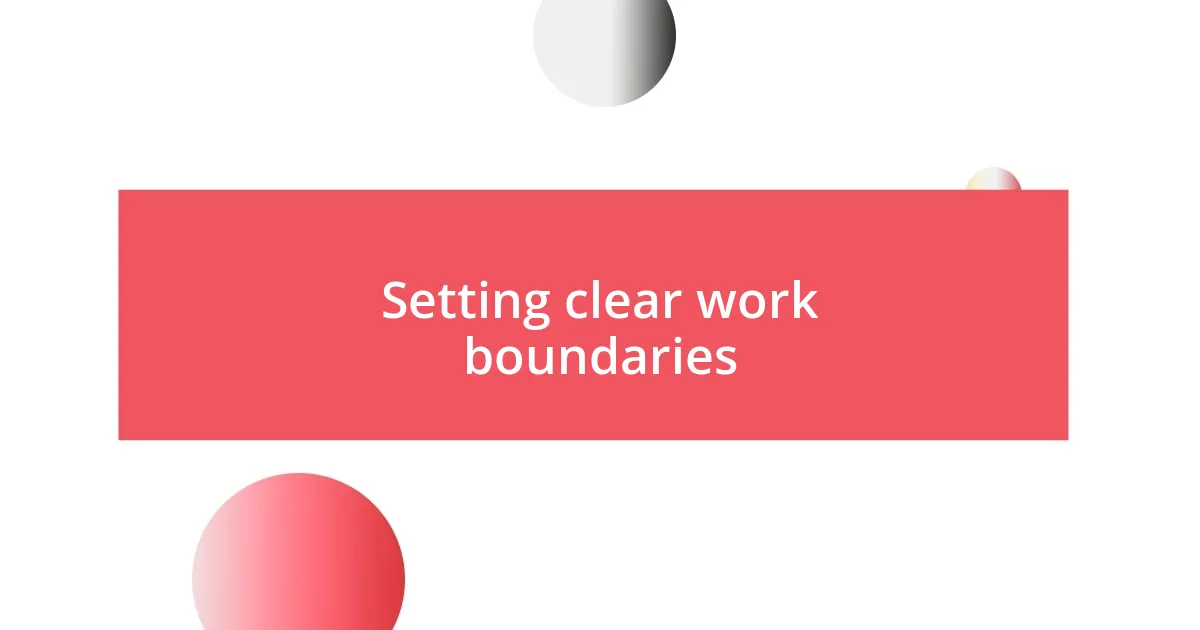
Setting clear work boundaries
Setting clear work boundaries was crucial for me to truly thrive while working from home. I quickly realized that just because I was at home didn’t mean my work should spill over into every hour of the day. Implementing specific start and end times for my workdays not only set expectations for myself but also provided others in my household with a clear understanding of when I’d be available. Have you ever felt the strain of work creeping into your evenings? I certainly have, and establishing these boundaries has been a game changer.
At first, it felt a bit rigid, but creating a definitive schedule allowed me to unwind guilt-free after hours. I began to truly cherish my evenings – watching my favorite shows or diving into hobbies without the nagging voice of unfinished tasks in the back of my mind. This separation has made my downtime feel more fulfilling. I would even suggest jotting down your boundaries and placing them somewhere visible as a reminder.
Additionally, I found it helpful to communicate my boundaries with friends and family. By explaining to them when I was “in the zone,” I encouraged them to respect those times as sacred. At first, I experienced moments of frustration when I was interrupted, but once I had those conversations, our relationships flourished. Have you had conversations like these? Being open about my work boundaries not only improved my productivity but also created a supportive atmosphere at home.

Utilizing productivity tools effectively
Utilizing productivity tools effectively made all the difference for my work-from-home journey. Initially, I felt overwhelmed by the sheer number of options available. However, I soon discovered that selecting a few key tools and mastering them was far more beneficial than spreading myself too thin. For instance, I started using a project management app to keep track of my tasks, which turned out to be a lifesaver. Have you ever lost track of what you intended to do on a busy day? It’s frustrating, isn’t it? This tool not only helped me prioritize my workload but also gave me a satisfying sense of accomplishment as I checked off completed tasks.
One of my favorite features of these productivity tools is the ability to integrate calendars and set reminders. At first, I would forget about important deadlines, but once I began leveraging this feature, my stress levels significantly decreased. I still remember an instance when I narrowly avoided missing an important meeting just because I had set a reminder for it. It’s these little victories that can uplift your day, right? By allowing technology to handle the details, I could focus on the big picture without the constant worry of what I might forget.
Beyond just task management, I found collaboration tools to be incredible for maintaining communication with my team. Regular check-ins became seamless, as sharing documents and updates in real-time kept everyone on the same page. It can feel isolating working from home, can’t it? However, through video calls and chat applications, I was able to cultivate a sense of belonging and camaraderie with my colleagues. This aspect opened up avenues for brainstorming sessions and feedback that I had missed in a traditional office setting, showing me that even while physically apart, we could still be connected and productive.

Staying connected with colleagues
Staying connected with colleagues was something I had to actively prioritize while working from home. I felt a bit lost in the beginning, as those spontaneous coffee breaks and chats by the water cooler were now replaced by silence. To bridge that gap, I started setting up weekly virtual catch-ups, filling that void with laughter and light-hearted conversation. Hasn’t it been refreshing to share a laugh over a screen? Those moments reminded me that we were still a team, even if we were miles apart.
I also found that using group chats for quick updates was invaluable. Initially, I struggled with the thought of texting my colleagues too often, but I realized it wasn’t just about me—everyone was missing those small interactions. By sharing memes, quick project updates, or just checking in on how everyone was doing, I fostered a sense of community. I remember one day when a colleague shared an embarrassing pet photo; the laughter that followed made our day so much brighter. Isn’t it amazing how even the simplest gestures can enhance the connection?
Moreover, I began to explore creative ways to engage with my team. For instance, I proposed a monthly virtual games night, and I was pleasantly surprised by the response. I can’t tell you how much joy it brought to see my coworkers let loose and enjoy themselves, all while connecting in a fun way. It struck me how vital these shared experiences were to our collective morale. Have you thought about what unique initiatives you could introduce to keep interactions lively? Personally, those evenings felt less like work and more like a reunion, reinforcing the idea that, physically separated or not, we were still together in spirit.

Maintaining work-life balance
Finding a work-life balance while working from home was a challenge I didn’t anticipate. At first, the lines blurred so much that my evenings turned into work marathons, leaving little room for personal time. I realized I needed strict boundaries—both physically and mentally. I started designating specific work hours, and believe me, shutting my laptop at 5 PM became my little victory. Have you noticed how liberating it feels to stick to a schedule?
One evening, after a particularly long day, I felt an overwhelming urge to keep working. Instead, I decided to step away and take a walk outside. The fresh air made a world of difference, lifting my spirits and refreshing my mind. It got me thinking—how often do we forget that stepping away is just as important as the tasks we complete? Incorporating breaks and setting aside time for family dinners helped me reestablish connections at home. Suddenly, those moments of togetherness became the highlights of my day, making my work seem less isolating.
I also experimented with creating a designated workspace. There’s something about sitting at a desk (even if it’s just a small corner of my living room) that mentally shifts me into “work mode.” Contrast that with lounging on the couch, where my mind might drift to my favorite Netflix show. It was enlightening to realize how much our physical environment influences our productivity and mindset. Do you have a spot that recharges you? Once I embraced this setup, I noticed I was able to separate work hours from personal time much more effectively, and, honestly, it felt like a game changer.










